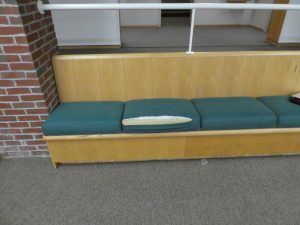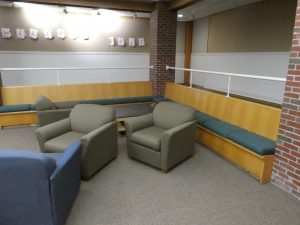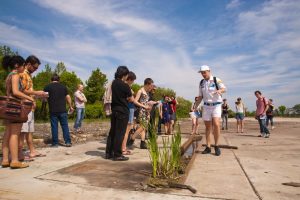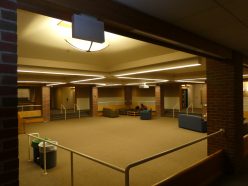Aesthetically speaking, there are not many grimmer places on campus than Brace Commons. The space serves as the central hub of the East Wheelock residential community, and connects all four dormitories in the cluster. The square-shaped center lacks substance and noteworthy design. A sprawling, unflattering grey carpet is the canvas for the commons, on which only a few small clusters of worn down furniture sit in the corners of the room.


Brace Commons is demarcated from its outer pathways by a three-step lowering in elevation, which makes users of the space actively conscious of their entrance. Adjacent wooden benches circle the entire space, but do not necessarily promote social or academic activities, as they force users to face forward (making it difficult to have a conversation) and there are no writing surfaces. The rest of the room is empty, with only the harsh fluorescent lights beating down onto the monotonous floor. The dull grey carpet, decaying, ripped furniture, and overall emptiness of Brace Commons deviates from the modern feel of many other campus spaces.
While the physical setup of Brace Commons is barren and alienating, in some senses, the space possesses untraditional beauty. This notion of beauty is not limited to appearance, but instead, includes the past and potential interactions that occur within the space. Artist Graham Coreil-Allen celebrates invisible places similar to Brace Commons. Many people do not give much thought to these spaces when they pass by due to a lack of noteworthy elements of design. Coreil-Allen argues that giving these apparent spaces of nothingness names starts the conversation about how they can be better utilized.


Without a name, Brace Commons would be a glorified pathway. With a name, the underwhelming emptiness of the space is applied and used effectively. The spacious, simple center is flexible for activities and meetings, including guest lectures, non-profit assemblies, concerts, Tae Kwon Do classes, and orientation icebreakers. Giving a name to the space makes nothing into something, a place where people can assemble and engage in the community.
Roman Mars, the creator and host of 99% Invisible, tests Coreil-Allen’s logic in asking: “What are the grounds for calling [these invisible spaces] beautiful?” These spaces are not beautiful in their appearance, but instead in their potential. For Coreil-Allen, the unobtrusive, unremarkable designs of places like Brace Commons gain beauty because they place a priority on the interactions that occur there. This utility in minimalism of design reveals that to truly understand how design functions, it is essential to look beyond physical elements and examine how space is actually used. Brace Commons is not a very appealing place, but hundreds of people flow through each day and there are many meaningful events that give the space purpose.


